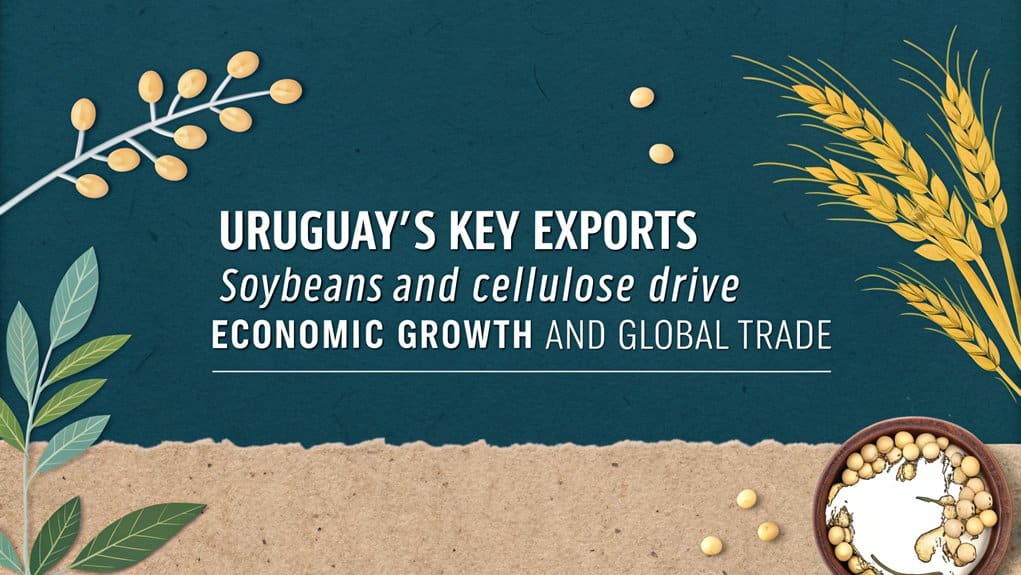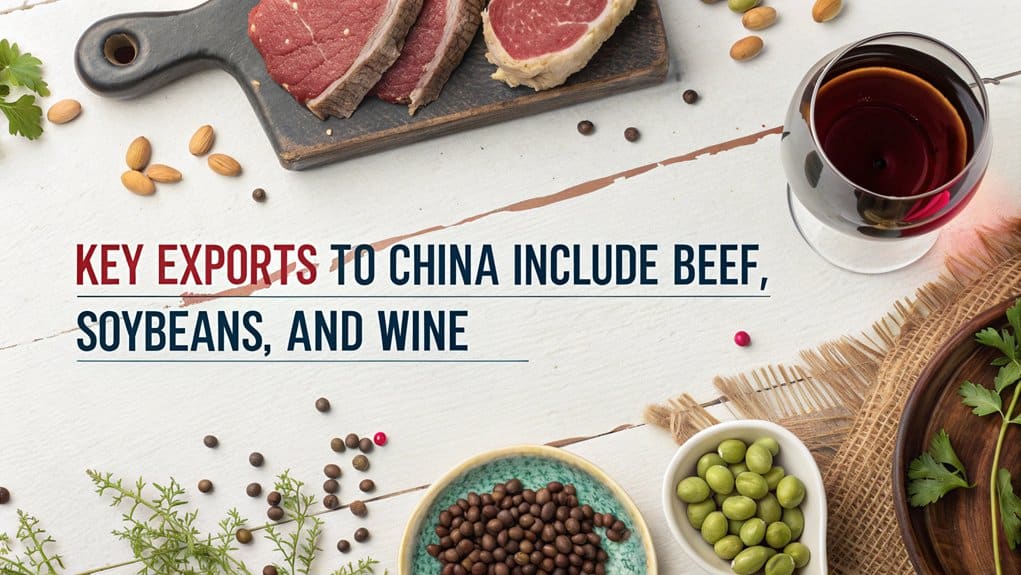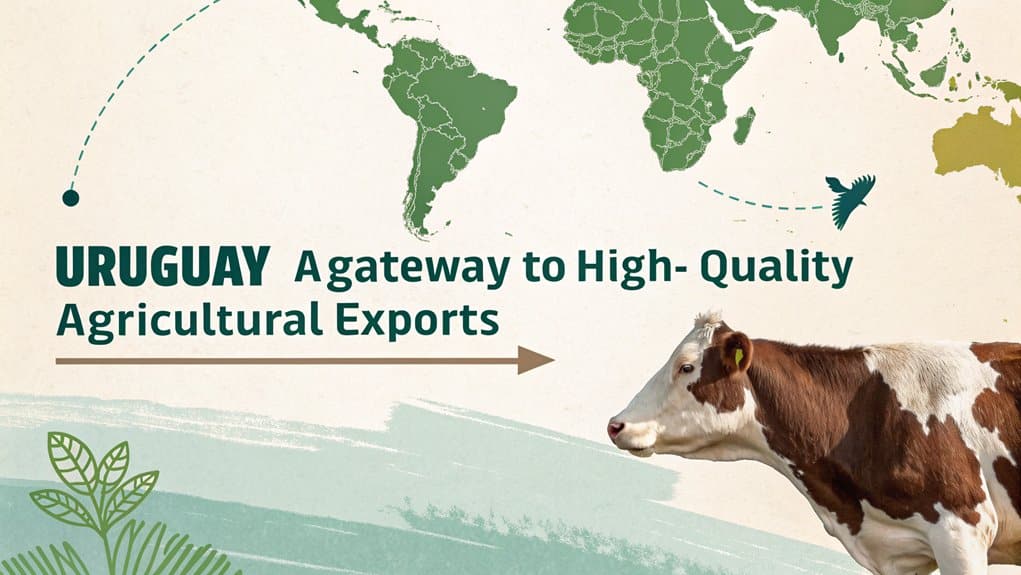Uruguay's place in global trade tells an intriguing story of agricultural prowess and market adaptability. The South American nation has carved out a distinctive niche as a premium exporter of beef, soybeans, and dairy products, with agricultural goods accounting for over 80% of its export portfolio. While its larger neighbors Brazil and Argentina often steal the spotlight, Uruguay's strategic focus on high-value products and stringent quality controls has earned it a reputation that punches well above its geographic weight.
Key Takeaways
- Beef is Uruguay's leading export, with over 361,720 tons exported in 2024, primarily to China and generating USD 3.1 billion.
- Soybeans are a major agricultural export, with production forecasted at 3.4 million tons for 2024/25, despite recent price fluctuations.
- Cellulose exports are surging, generating $1.607 billion in early 2024, boosted by UPM's second pulp mill operations.
- Dairy products form a significant part of Uruguay's agricultural exports, contributing to the country's $21 billion total export value.
- Frozen bovine meat ($978 million) and sulfate chemical woodpulp ($783 million) dominate Uruguay's exports to China, their largest trade partner.
Uruguay's Position in Global Trade

While Uruguay may not dominate global trade rankings, its strategic position in South America and diverse export portfolio have established it as a noteworthy player in international commerce. Recent trade statistics place Uruguay at 81st among global exporters and 90th for imports, reflecting its moderate but stable presence in international markets.
Economic analysis reveals Uruguay's impressive 52nd position in the Economic Intricacy Index, suggesting sophisticated production capabilities despite its relatively modest GDP ranking of 81st globally. The country's strategic advantage stems from its position between Brazil and Argentina, complemented by its network of 11 free trade zones. This infrastructure, combined with its Mercosur membership, enables Uruguay to punch above its weight in regional trade dynamics, particularly in agricultural and forestry products. The nation's export strength is particularly evident in its Sulfate Chemical Woodpulp sector, which generates $2.11B in annual exports.
The Power of Agricultural Exports
Uruguay's agricultural exports showcase an impressive portfolio led by high-value commodities like beef, soybeans, and dairy products, which collectively generate billions in annual revenue. The nation's strategic focus on agricultural expansion has created a robust economic foundation, with export figures reaching record levels and showing consistent year-over-year growth across multiple sectors. The country's cereal exports increased from USD 819,088 thousand in 2022 to USD 902,175 thousand in 2023. Through carefully cultivated trade relationships and quality-focused production standards, Uruguay has established itself as a trusted global supplier, reaching markets from China to Europe and cementing its position as a key player in international agricultural trade.
Leading Agricultural Export Products
As one of South America's agricultural powerhouses, Uruguay has cultivated a robust portfolio of export products that dominate international markets. The country's agricultural diversification strategy has positioned it as a reliable supplier of premium beef, with annual exports reaching 475,000 tons cwe, alongside substantial soybean production forecast at 3.4 million metric tons for 2024/25.
Export sustainability remains central to Uruguay's success, with forestry products, dairy, and cereals rounding out its impressive offerings. China leads as the primary destination, absorbing 27% of exports, particularly beef and soybeans, while Brazil and Argentina maintain strong regional trade relationships. This strategic mix of commodities, supported by modern infrastructure and sustainable practices, has established Uruguay as a vital player in global agricultural markets. The country's wheat production outlook shows 1.3 million tons for MY 2024/2025, reflecting its significant role in global grain markets.
Growth Drives Economic Stability
Stability marks the cornerstone of Uruguay's economic success story, with agricultural exports serving as the primary engine of growth. The nation's commitment to sustainable practices and export diversification has enabled it to reach over 160 international markets, feeding approximately 30 million individuals worldwide.
From 2004 to 2014, Uruguay experienced robust economic expansion, though growth moderated to 1.3% annually between 2015 and 2019. The country's resilience became evident as it bounced back above pre-pandemic levels in 2022, supported by its strong institutional framework and transparent business environment. While the agro-industrial sector represents 14-16% of GDP, its impact extends far beyond these numbers, accounting for an impressive 82% of total goods exports. This agricultural prowess, combined with sound economic policies, continues to attract foreign investment and foster long-term stability. The nation's top export commodities include beef and soybeans, which generated over $4.4 billion in revenue in 2022.
Global Market Reach Impact
Through strategic market positioning and relentless quality standards, Uruguayan agricultural exports have carved out an impressive presence across more than 160 global markets, delivering premium products from beef to soybeans.
Despite a 13% annual decline in overall exports during 2023, the nation's commitment to global quality is evident in its diverse export portfolio, with beef exports reaching $2.3 billion in 2023, while wood products contributed $1.2 billion to the economy. China, Brazil, and the European Union remain key destinations, drawn by Uruguay's reputation for export sustainability and agricultural excellence.
The agricultural sector's 14-16% contribution to GDP highlights its vital role in Uruguay's economic terrain. With strategic investments in technology and infrastructure, coupled with environmentally conscious farming practices, Uruguay continues to strengthen its position as a trusted supplier of premium agricultural products worldwide.
Beef: Uruguay's Export Champion
Uruguay's position as a beef export powerhouse continues to evolve, with the nation shipping over 361,720 tons in 2024 despite a slight 0.4% year-over-year decline. While China's reduced purchases posed initial challenges, Uruguay demonstrated remarkable market adaptability by successfully redirecting exports to the United States, which increased its intake by an impressive 84%. This strategic shift, combined with Uruguay's reputation for high-quality beef across more than 50 international markets, showcases the country's resilience and growing influence in global meat trade dynamics. The country reached a notable milestone with record 45,000 tonnes of beef exports in December, reinforcing its status as a leading global supplier.
Beef Production Growth Trends
Recent decades have witnessed remarkable growth in Uruguay's beef production sector, with the nation's cattle herd reaching an impressive 11.8 million head in 2023 and generating USD 3.1 billion in export revenue. The country's commitment to beef sustainability and market adaptability has driven a 50% increase in livestock productivity over the past two decades.
This growth stems from strategic improvements in animal genetics, nutrition, and production efficiency, while maintaining Uruguay's signature pasture-based systems where cattle spend over 90% of their lives grazing. The integration of modern technologies has helped stabilize production cycles despite climate variability, while the nation's hormone-free, traceable production methods continue to appeal to environmentally conscious consumers worldwide. The country's strict traceability standards have become a cornerstone of its export success. These advancements position Uruguay as a leading player in sustainable beef production.
Global Market Share Impact
Three significant market shifts have changed Uruguay's position in the global beef trade, with the nation's strategic expansion into markets previously dominated by Argentina yielding remarkable results. Through calculated export diversification strategies and competitive market analysis, Uruguay has emerged as a powerhouse in global beef exports.
- Capturing China's market share, becoming the second-largest South American supplier behind Brazil
- Leveraging sustainable farming practices to secure premium positions in U.S. and EU markets
- Achieving a remarkable $2.09 billion in exports for 362,137 tons in 2024
- Implementing strategic trade agreements and meeting rigorous international standards
The country's early adoption of wire fencing in 1872 revolutionized their cattle ranching capabilities, setting the foundation for modern export success. This change has positioned Uruguay as a reliable supplier of high-quality beef, with projections indicating continued growth to 475,000 tons by 2025.
Soybeans and Cellulose Market Impact

Two essential commodities have emerged as the backbone of Uruguay's export market: soybeans and cellulose, collectively shaping the nation's economic terrain through their substantial contributions to foreign revenue. Despite significant soybean fluctuations, with exports plummeting 78% to $414 million in 2023, strategic cellulose investments have helped maintain economic stability. The opening of UPM's second pulp mill has propelled cellulose exports to an impressive $1.607 billion in early 2024, marking a 34% increase. While soybeans face challenges from declining international prices and weather dependencies, the projected harvest of 2.9 million MT signals a recovery. Free Zones trading accounts for 268,417 tons of soybean exports, demonstrating the crucial role of these special economic areas. However, with cellulose production reaching maximum capacity across three major mills, both sectors must maneuver carefully through global market dynamics to sustain growth.
Key International Trade Partners
As Uruguay's global trade footprint continues to expand, China and Brazil have emerged as the nation's dominant trade partners, together accounting for more than $4.2 billion in exports during 2023. A comprehensive partner analysis reveals the strategic importance of regional and global relationships, fortified through trade agreements like MERCOSUR and ALADI. Trade relationships are strengthened through Free Zones operations that serve as vital export hubs.
- China leads as the primary export destination with $2.34 billion, particularly interested in Uruguay's agricultural products and sustainable farming practices
- Brazil maintains strong bilateral trade dynamics, importing $1.92 billion while serving as Uruguay's largest import source
- The United States represents a growing market opportunity, receiving $880 million in exports
- European connections remain vital, with the Netherlands emerging as a key trade gateway, importing $568 million in Uruguayan goods
China's Role in Uruguayan Exports

China has established itself as Uruguay's largest export destination, with bilateral trade reaching an impressive $2.34 billion in 2023, primarily driven by agricultural and forestry products. The relationship centers on three key exports: frozen bovine meat ($978 million), sulfate chemical woodpulp ($783 million), and edible offal ($138 million).
While this trade partnership has proven lucrative, Uruguay's heavy reliance on the Chinese market has sparked ongoing trade negotiations with other regions. Export diversification efforts are underway to reduce economic vulnerability, though China's sustained demand for Uruguayan beef and agricultural products makes it an indispensable partner. The relationship continues to evolve, with Uruguay exploring opportunities to expand beyond traditional commodities and tap into service-based exports, all while maintaining its position as a trusted supplier to the Asian giant. Recent data shows exports grew 61.9% compared to December 2023, indicating strengthening trade ties between the two nations.
European Union Market Dynamics
While China dominates Uruguay's export terrain, the European Union stands as another vital trade partner, with bilateral commerce reaching US$1.93 billion in 2022. Trade agreements between these regions have opened pathways for diverse economic strategies, particularly in key sectors like machinery, pharmaceuticals, and vehicles. The recent historic trade agreement at the 2024 Montevideo summit marks a new chapter in EU-Mercosur relations.
The EU market's significance for Uruguay is evident through:
- Substantial machinery and nuclear reactor exports valued at $380.32 million
- Strong pharmaceutical trade reaching $339.84 million
- Vehicle exports totaling $160.58 million
- Robust agricultural ties, with cellulose and beef leading Uruguayan exports
The EU-Mercosur agreement promises to reshape this relationship further, creating a combined market of 700 million consumers and fostering innovation across both regions.
Raw Materials and Product Categories

Uruguay's raw materials vistas has undergone a remarkable change in recent years, with cellulose emerging as the crown jewel of its export portfolio at $2.545 billion, dethroning the traditionally dominant beef sector.
Beyond the cellulose exports surge, which now represents 20% of total exports, the country's raw materials showcase impressive diversification. Soybean growth has been particularly noteworthy, with export volumes skyrocketing by 259% despite an 18% drop in international prices. The agricultural sector remains robust, featuring dairy products dominated by milk powder, while wood and forestry products contribute significantly with $1.2 billion in exports. This shift reflects Uruguay's evolving economic environment, where traditional powerhouses like beef, now at 16% of exports, coexist with emerging industrial strengths. The nation's export success has created 64,000 direct jobs across industry, agriculture, and livestock sectors.
Economic Growth Through Exports
Uruguay's remarkable export growth stems from a powerful combination of modern services, strategic agricultural development, and expanding trade partnerships that generated over $21 billion in export value for 2022. The country's success in developing key relationships with major markets like China and the European Union has created robust trade channels, with exports now contributing 27% of the economy's gross added value. Agricultural innovation and diversification into sectors like ICT have proven particularly fruitful, creating over 356,000 jobs and positioning Uruguay as an increasingly important player in global trade. Modern services have emerged as the nation's leading export sector, generating US$ 3.625 billion in gross added value.
Key Export Growth Drivers
Surging commodity prices and robust international demand propelled Uruguay's remarkable economic growth through exports from 2004 to 2014, marking a groundbreaking period for the nation's economy. The country's export diversification strategies and ongoing infrastructure development challenges continue shaping its trade terrain. China's increasing appetite for commodities has been particularly transformative for Uruguay's export market, with the Asian giant now accounting for 27% of exports.
Key drivers of Uruguay's export growth include:
- Agricultural commodities and derivatives comprising 50% of total exports
- Modern services sector expansion, particularly in IT and financial services
- Strategic shifts toward value-added products like cellulose and wood processing
- Sustained commodity price advantages during the early 2000s boom years
This diverse export portfolio has helped Uruguay maintain economic resilience while pursuing greater market freedom and independence from regional economic fluctuations.
Trade Partnerships Pay Off
Strategic partnerships with major trading nations have changed the economic scenery of this South American nation, with exports reaching more than 160 countries worldwide. China leads the pack, consuming 27% of Uruguay's exports, while the European Union and Brazil maintain robust trade relationships that minimize tariff impacts through preferential agreements.
These partnerships have proven instrumental in establishing reliable supply chain networks, particularly for Uruguay's powerhouse exports: cellulose ($2.5 billion) and beef ($2 billion). The diversification of trade relationships has created a buffer against regional economic volatility, fostering sustained GDP growth and enhancing employment opportunities. With agricultural products comprising over 80% of exports, Uruguay's strategic position in global markets continues to strengthen its economic resilience and investment-grade status. The country's remarkable 10.55% growth rate demonstrates the success of its export-driven economic strategy.
Strategic Agricultural Development
Through careful cultivation of its agricultural sector, the South American nation has changed itself into an export powerhouse, with farm products accounting for more than 80% of total goods shipped abroad. Uruguay's commitment to sustainable practices and production efficiency has reshaped its agricultural terrain, reaching over 170 global destinations.
The country's growing international presence is highlighted by its thriving trade with major export destinations, including China at 24%, Brazil at 18%, and the European Union at 14% of total sales.
Key developments driving Uruguay's agricultural success:
- Cellulose exports surged to $2.545 million in 2024, representing 20% of total exports
- Enhanced port infrastructure boosting logistics capabilities and market access
- Implementation of low-carbon farming methods attracting environmentally conscious buyers
- Strategic partnerships with international organizations advancing sustainable agriculture
This remarkable growth has created 64,000 jobs while positioning Uruguay as a leader in eco-friendly agricultural exports, particularly in beef, soybeans, and dairy products.
Trade Balance and Market Stability
Uruguay's trade balance presents an intricate portrait of economic resilience amid persistent deficits, with recent figures showing a $213.5 million shortfall in January 2025. Despite these challenges, the nation maintains remarkable market stability through diversified export channels and strategic trade partnerships. The country's robust pharmaceutical sector contributes significantly to its export portfolio, with medicament exports reaching $95,697,997 in 2023.
While the average monthly deficit since 1993 hovers around $74.1 million, Uruguay's economic framework demonstrates adaptability through its robust agricultural sector and growing international market presence. The country's trade dynamics, though showing consistent deficits, benefit from strong relationships with major partners like China ($2.58 billion in exports) and Brazil ($1.74 billion). Market fluctuations are effectively managed through Uruguay's commitment to sustainable practices, politically stable environment, and strategic use of Free Trade Zones, positioning the nation as a reliable regional trade hub.
Future Export Opportunities

Building on its established trade foundations, the South American nation stands poised to unlock an array of promising export opportunities in the coming years. Uruguay's strategic push into emerging markets coupled with its focus on product diversification positions the country for substantial growth beyond its traditional agricultural stronghold. With free trade zones generating over $4 billion in exports annually, the country has a robust foundation for future growth.
- Aluminum ore presents a significant opportunity to expand into mineral exports, breaking away from purely agricultural commodities.
- Sorghum cultivation offers potential for diversifying grain exports, particularly to Asian markets.
- Oily seeds development aligns with global demand for alternative protein sources.
- Technology-enabled services, supported by the country's 90%+ internet penetration and robust digital infrastructure, represent an untapped export sector.
Currently ranked 52nd in economic intricacy, Uruguay's commitment to expanding its export portfolio signals a promising trajectory toward more sophisticated market offerings.



